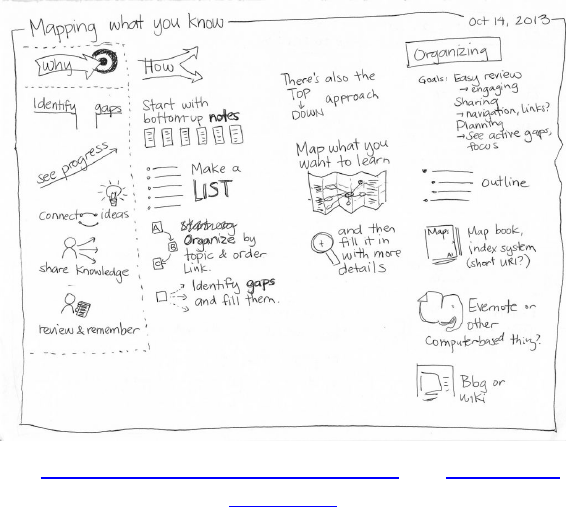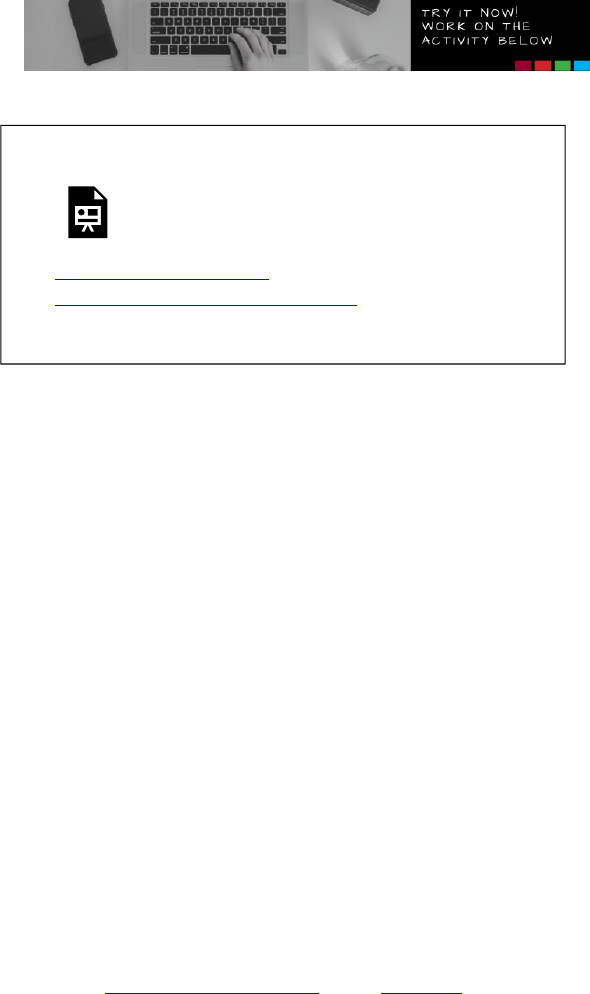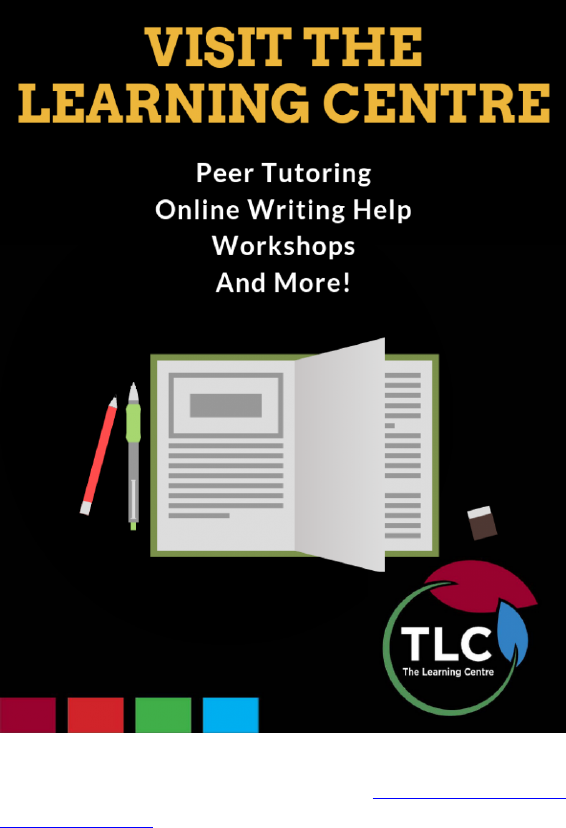Academic Writing Basics
Academic Writing Basics
Megan Robertson
KWANTLEN POLYTECHNIC UNIVERSITY
SURREY, BC
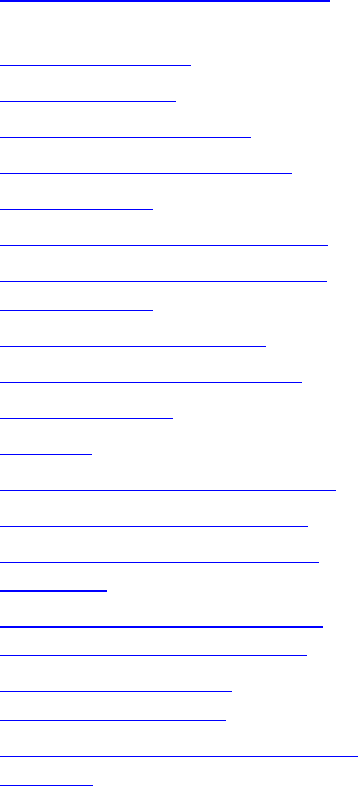
65;-5;:
Part I. Academic Writing Basics
1. Acknowledgements 1
2. Table Of Contents 3
3. How this Resource Works 5
4. Assessing Current Knowledge 7
5. Building Basics 11
6. Thinking About Your Assignment 17
7. Keyword Clues - Determining the
Type of Writing
21
8. Types of Academic Writing 27
9. Breaking Down an Assignment 31
10. Concept Mapping 35
11. Outlining 45
12. Developing Your Thesis Statement 53
13. Refining Your Thesis Statement 61
14. Planning Your Writing - Drafting
Paragraphs
65
15. Planning Your Writing - Quoting,
Paraphrasing, and Summarizing
67
16. Planning Your Writing -
Incorporating Evidence
75
17. Planning Your Writing - Overcoming
Obstacles
83
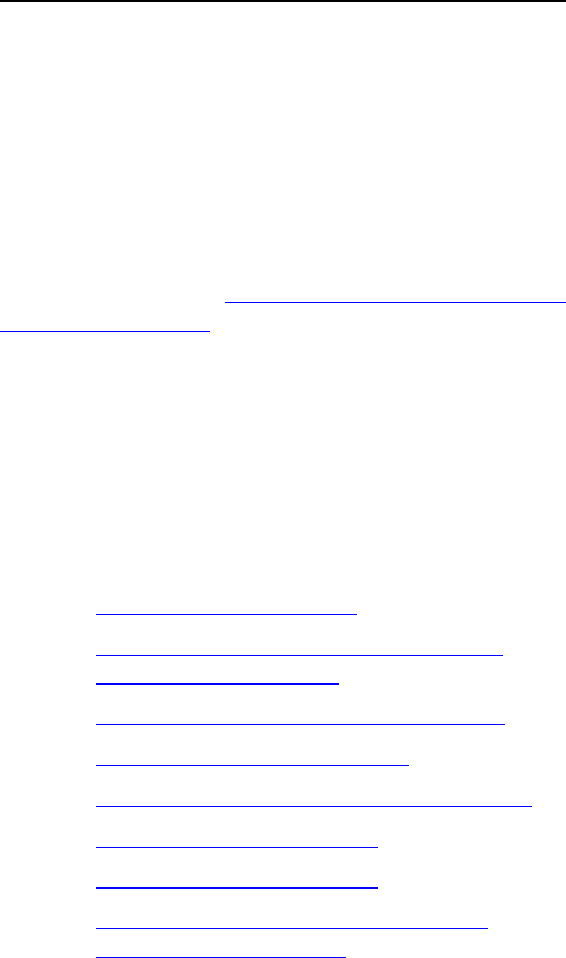
+256>3-,/-4-5;:
Academic Writing Basics draws on and synthesizes the
contributions of the Kwantlen Polytechnic University
Learning Centre team, including source materials, learning
aids, and workshop content created and updated by
Learning Strategists, Learning Centre Staff, and Peer
Tutors. Thanks to Karen Meijer-Kline, Mustafa
Mohammed, and Rajiv Jhangiani for their technical
assistance on this project. Kim Tomiak provided helpful
editorial suggestions.
Academic Writing Basics adopts and adapts Open
Access material from a variety of sources including:
• College of DuPage Library
• Department of Writing and Rhetoric at the
University of Mississippi
• The Excelsior College Online Writing Lab
• Mount Royal University Library
• University of California Los Angeles Library
• University of Guelph Library
• University of Laurier Library
• University of Northern British Columbia
Academic Success Centre
1

• Saylor Academy
• The Word on College Reading and Writing by
Carol Burnell, Jaime Wood, Monique Babin,
Susan Pesznecker, and Nicole Rosevear
These sources are credited where the material appears.
Material in “Types of Academic Writing” is reproduced
with permission from The University of Sydney Learning
Centre.
2 Megan Robertson
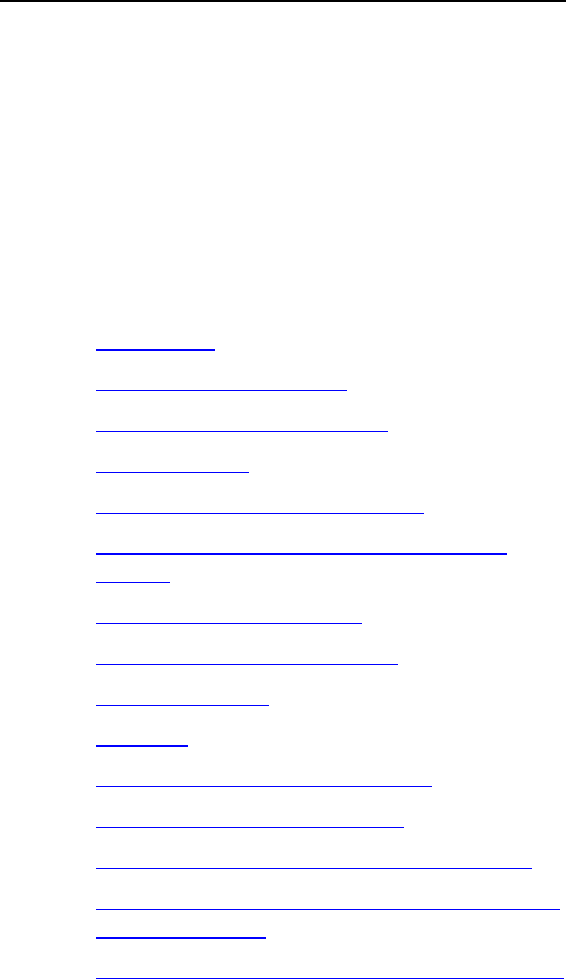
$)*3-.65;-5;:
65;-5;:
• Introduction
• How this Resource Works
• Assessing Current Knowledge
• Building Basics
• Thinking About Your Assignment
• Keyword Clues – Determining the Type of
Writing
• Types of Academic Writing
• Breaking Down an Assignment
• Concept Mapping
• Outlining
• Developing Your Thesis Statement
• Refining Your Thesis Statement
• Planning Your Writing – Drafting Paragraphs
• Planning Your Writing – Quoting, Paraphrasing,
and Summarizing
• Planning Your Writing – Incorporating Evidence
3

6>;01:"-:6<9+-'692:
@9-),15/)5,+6473-;15/)+;1=1;1-:15;01:9-:6<9+-
@6<>133*-)*3-;6
• Consider the process of academic writing;
• Determine the type of academic writing you
might be asked to complete;
• Review approaches to developing and
structuring ideas using concept mapping and
outlining;
• Work on how to develop a thesis statement or
controlling idea;
• Consider strategies for planning your writing
assignment, including:
◦ Drafting paragraphs
◦ Quoting, paraphrasing, and
summarizing
◦ Incorporating evidence, and
◦ Overcoming obstacles;
• Use key questions for revising and editing.
5

There are activities for you to do throughout this
resource. Each activity will have this banner above it:
6 Megan Robertson

::-::15/<99-5;56>3-,/-
7
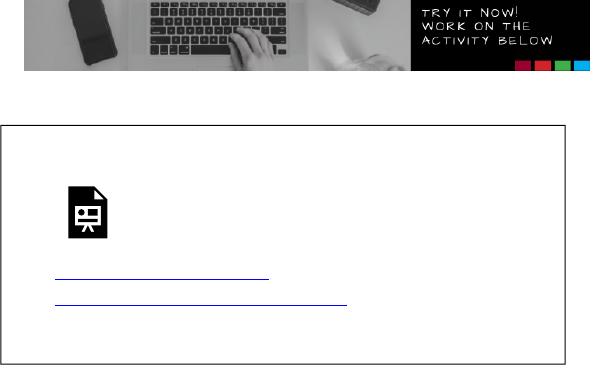
If you are new to academic writing, have done some
academic writing, or are already an experienced academic
writer, there is always more to learn!
Reflecting on your current writing process can help you
decide what steps to take next.
Take the quiz below to determine if you are currently at
the beginning stages of academic writing, the intermediate
stages, or in the experienced stages.
An interactive H5P element has been excluded
from this version of the text. You can view it
online here:
https://kpu.pressbooks.pub/
academicwritingbasics/?p=27#h5p-1
9

<13,15/):1+:
11
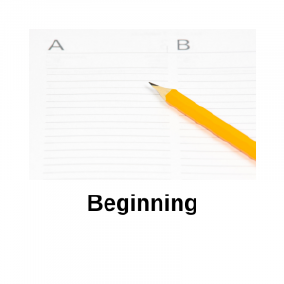
As we cover academic writing basics, you’ll see tips and
suggestions especially for beginning academic writers.
Intermediate and experienced academic writers can also
use these strategies and approaches.
Based on your current stage of academic writing,
consider how the information and examples used in this
Pressbook may be applied for your specific background
and experience:
Beginning writers may
want to closely follow
templates and resources to
learn more about
conventions and
expectations of academic
writing. This can help you
become more familiar with
the basics of academic
writing.
13

Intermediate writers
may have some knowledge
of the conventions and
expectations of academic
writing. Adapting and
extending examples used
in this workshop can help
further develop your
writing skills and your
own voice as an academic
writer.
Creatively reflecting on
the material in this
workshop can help
experienced academic
writers further refine
ideas. By experimenting
with different approaches
that complement your
existing writing process,
you can learn more about
how to best showcase your
research and discussion.
14 Megan Robertson
15

$015215/*6<;(6<9::1/54-5;
17

“The Thinker” by Auguste Rodin CC0 1.0
When you receive your writing assignment from your
instructor, it’s important to stop and think. What are the
requirements? What is the purpose of this assignment?
What is your instructor asking you to write? Who are you
writing for?
Before you begin to write any part of an assignment,
think about the requirements and how you plan to meet
those requirements. It’s easy to jump into an assignment
without stopping to think about and analyze the assignment
requirements.
What does it mean to think about and analyze
assignment requirements?
It means that you’re considering the purpose of the
assignment, the audience for the assignment, the voice you
19

might want to use when you write, and how you will
approach the assignment effectively overall.
With each writing assignment, you’re being presented
with a particular situation for writing. Learning about
assignment requirements and expectations can help you
learn to make good decisions about your writing.
Every writing assignment has different expectations.
There is no such thing as right, when it comes to writing;
instead, try to think about good writing as being writing
that is effective in that particular situation.
Adapted from “Thinking about Your Assignment” by
Excelsior Online Writing Lab CC BY 4.0
20 Megan Robertson

-@>69,3<-:-;-941515/;0-$@7-
6.'91;15/
21

When you receive an assignment from an instructor, paying
close attention to the assignment description and
expectations can help you determine what will be most
effective for your writing.
Looking for and highlighting keywords in your
assignment can help you know what your instructor
expects. Try it out! Match the keywords below with their
definitions:
23
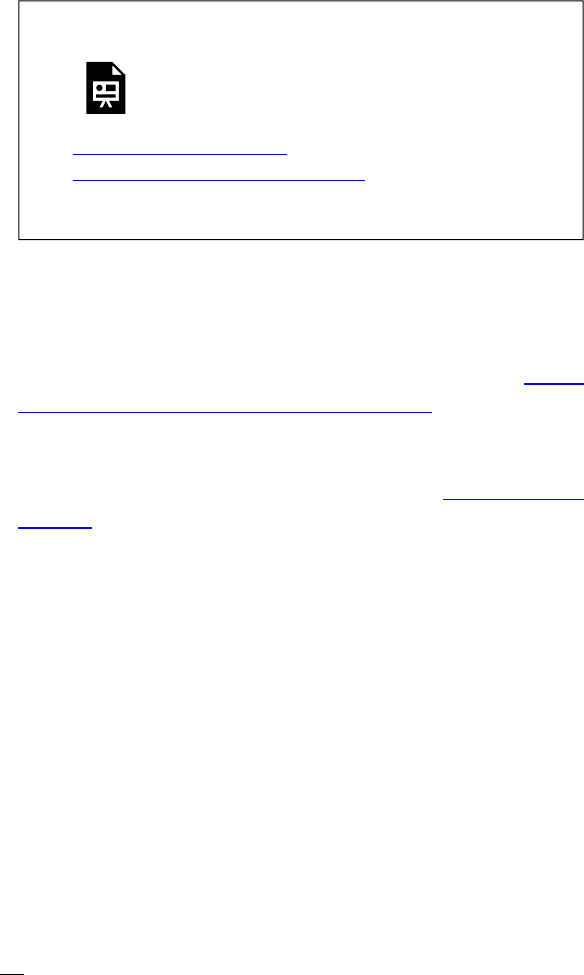
An interactive H5P element has been excluded
from this version of the text. You can view it
online here:
https://kpu.pressbooks.pub/
academicwritingbasics/?p=36#h5p-4
1
These are just some of the keywords that you might see
in an assignment. Review the KPU Learning Aid “Terms
that may be used in essays or examinations” to see more
Beginning, intermediate, or experienced as an academic
writer, if you are uncertain about assignment requirements
– ask your instructor! You can also visit the KPU Learning
Centres for help with determining what type of writing you
are being asked to do.
In the next section, we’ll take a closer look at
four of the common types of academic writing that
you might encounter and the keywords that are
associated with each type of writing.
1.
2
2. [1]
24 Megan Robertson
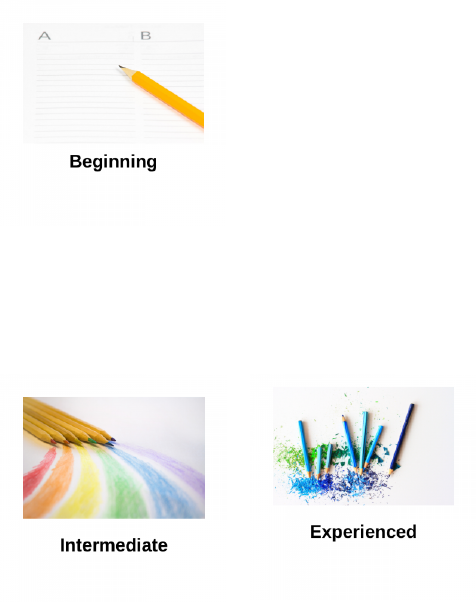
If you are a beginning
academic writer, in your first
semester of university studies,
you will likely start with some
descriptive writing.
By the end of your first
semester, you may be expected
to include analysis, persuasion,
and critique in your writing.
Most of the academic writing you will do as a university
student will include a combination of these different types
of writing.
If
you
are an
intermediate or experienced
academic writer, you may already be familiar with these
type of writing.
Below, we’ll look more closely at the four different types
of writing (descriptive, analytical, persuasive, and critical)
and consider strategies for developing ideas.
Click on the titles to expand the sections.
28 Megan Robertson

An interactive H5P element has been excluded
from this version of the text. You can view it
online here:
https://kpu.pressbooks.pub/
academicwritingbasics/?p=59#h5p-2
1
1. Description and discussion of types of writing reproduced, with permission,
from "Types of Academic Writing" by University of Sydney Learning
Centre https://sydney.edu.au/students/writing/types-of-academic-
writing.html
Academic Writing Basics 29

9-)215/6>5)5::1/54-5;
Once you know about the expectations related to the type
of writing that you are required to do, you can make a plan
to gather information and develop your ideas.
Let’s look at an example, we’ll come back to this
example throughout the different sections of this
Pressbook…
An instructor in a first-year communication course asks
students to complete the following assignment:
Write a 1,500 word persuasive essay that responds to
the question: “Are transit services effective for Kwantlen
University students?” Include your own perspective in
your analysis and draw on two academic sources.
31
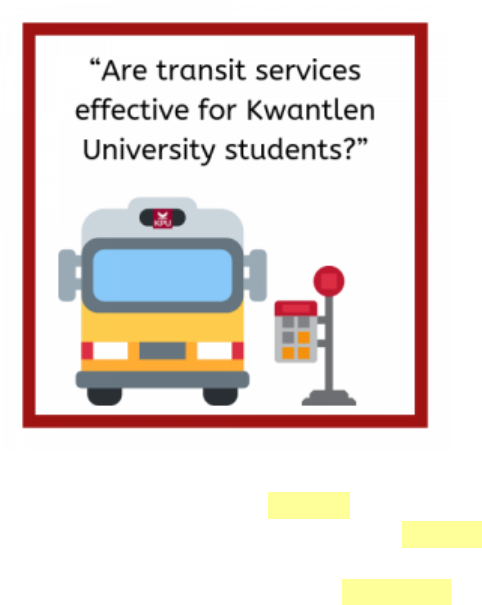
In my assignment, I’ll need to describe transit services.
Once I have my description, I can include some analysis of
those services, based on my own perspective and sources
that I’ll need to identify. Because this is a persuasive essay,
I want to make sure that I’m presenting a clear argument.
I can already see that I’ll be using three types of academic
writing in this one assignment!
As I work on my assignment, it is important that I keep
checking back with the assignment instructions; I want to
make sure that I’m staying on topic and responding to the
question.
Now that I have an understanding of the type of
assignment that I’m working on, I can begin to develop
ideas, gather information, and organize what I want to
say. We’ll look more closely at brainstorming and concept
mapping, next.
32 Megan Robertson
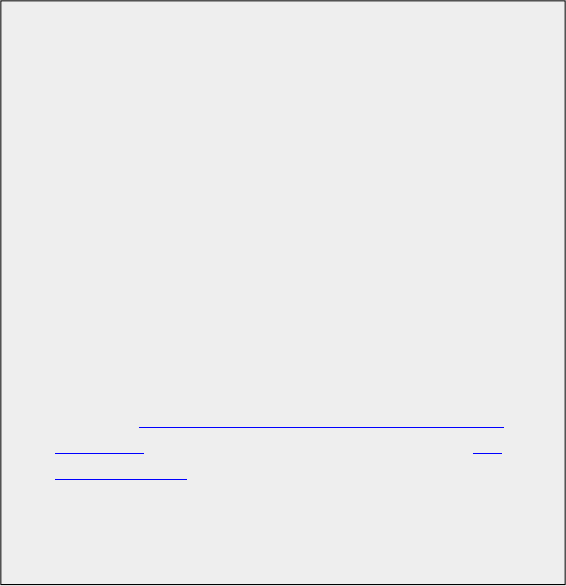
What are Academic Sources?
Academic Sources:
• Are published in a peer-reviewed
journal or by a reputable publisher
• Use academic or scholarly language
• Include a reference list
• Include the author’s credentials
• Report the results of some kind of
research or study
From “General Education: Scholarly and Popular
Resources” by Mount Royal University Library CC
BY-NC-SA 4.0
Academic Writing Basics 33
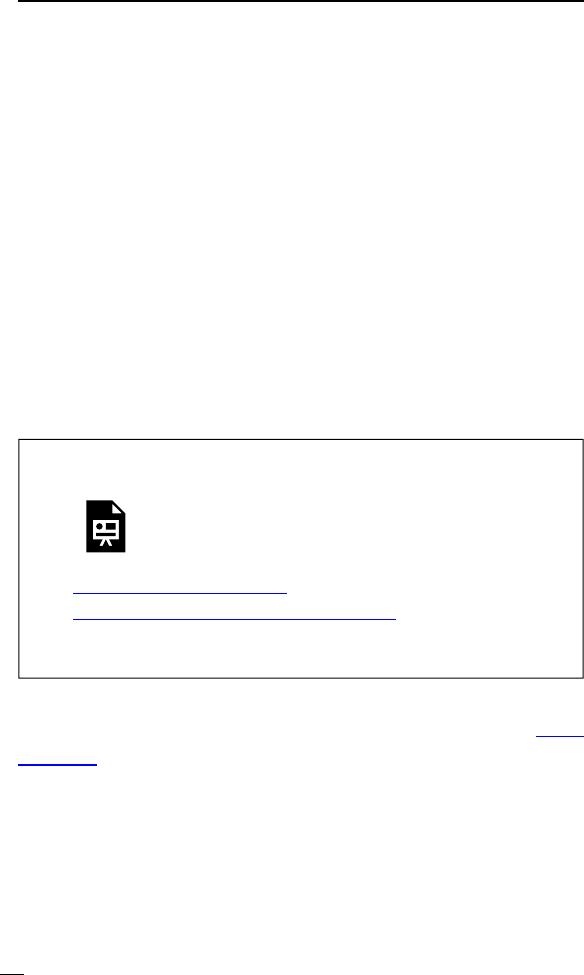
65+-7;)7715/
Creating a concept map is a way of organizing your
brainstorming around key concepts.
This video from the University of Guelph offers a brief and
helpful overview of concept mapping:
1
One or more interactive elements has been
excluded from this version of the text. You can
view them online here:
https://kpu.pressbooks.pub/
academicwritingbasics/?p=44#oembed-1
Ready to get started with a concept map? This KPU
learning aid can also help guide you through the process.
Let’s use our example where an instructor has given us
the assignment: Write a 1,500 word persuasive essay that
responds to the question: “Are transit services effective
for Kwantlen University students?” Include your own
1.
2
2. [1]
35
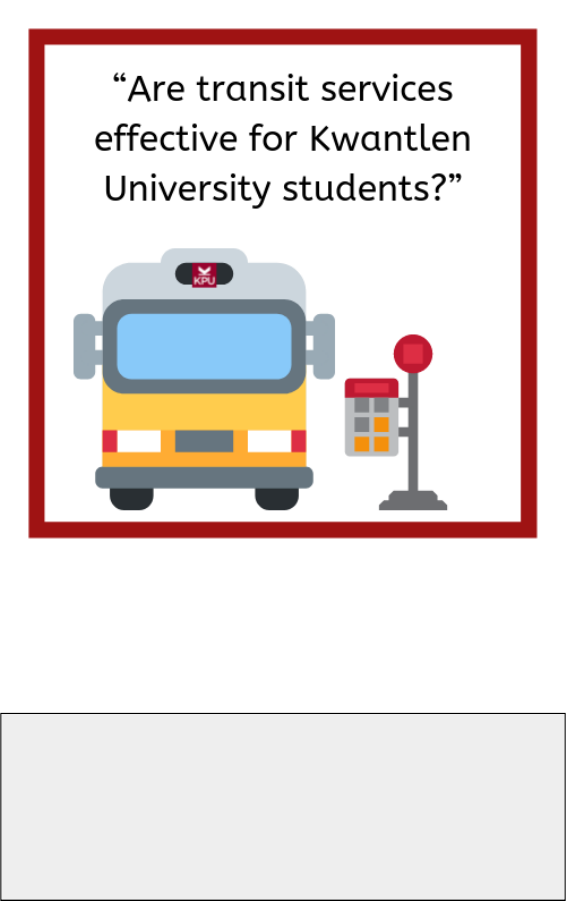
perspective in your analysis and draw on two primary and
two academic sources.
We’ll follow the seven steps of concept mapping
outlined in the video above and I’ll include some examples.
If you have your own assignment that you are
currently working on, use the steps below to make
your own concept map for your assignment.
36 Megan Robertson
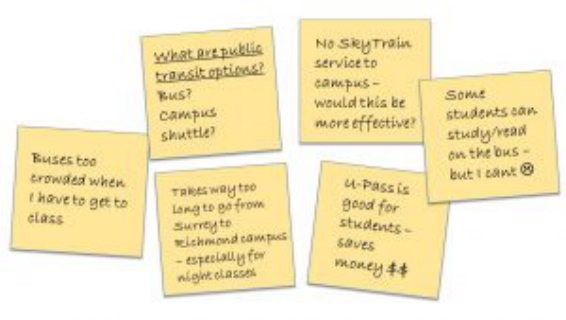
#;-75-
• Identify the main topic
• Brainstorm everything you know about the topic
• Use relevant content from course, lectures,
textbooks, and course material
Sticky notes can be a great way of jotting down ideas
– you can move the notes around as you begin to identify
similarities and differences. You can also ask questions and
include reminders of work that that you need to do. See the
example below of some sticky notes I might use to start my
assignment:
I’ll add more sticky notes with key questions that
relate back to the assignment – I’ll need to find
primary and academic sources:
Academic Writing Basics 37
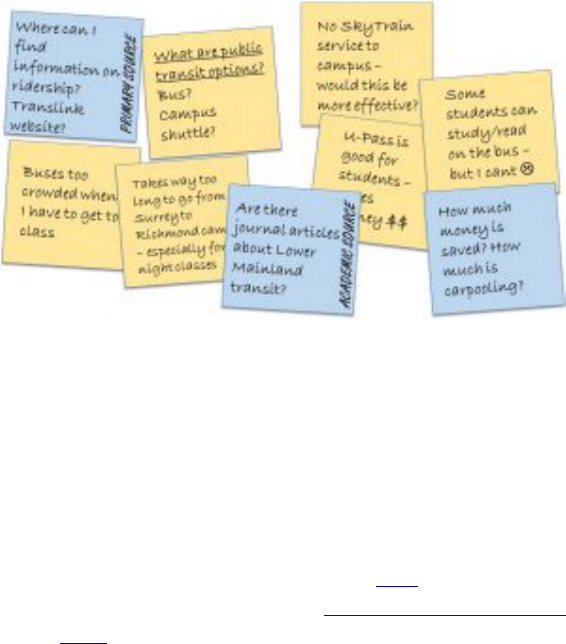
I can use these questions as I begin my research
process and identify the primary and academic
sources I need to support the argument that I will
make.
To find out more about the research process, visit
any of KPU’s libraries to get help from a librarian, or
review one of the helpful guides here to get started.
This video, included in KPU Library’s Research
Help page, provides a good overview of working
with an assignment to make sure that you develop a
response that is specific and well-supported:
#;-7$>6:
• Organize information into main points
After noting down what I know about my topic and
identifying key questions that I’ll need to research
everything, I can focus on a few things that will be
38 Megan Robertson
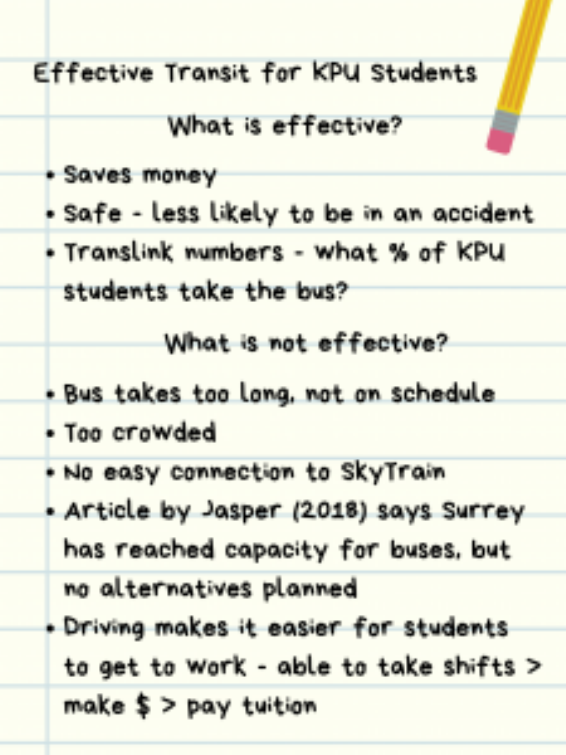
important to describe and analyze in my essay. I’ve made a
list of some that I can use:
Based on what I’ve done so far, I’m setting up a
descriptive comparison of transit options for KPU students,
but will emphasize that current transit options are not
Academic Writing Basics 39

effective. I want to look for further connections between
ideas and see how I can shape my argument.
#;-7$09--:
• Start creating map
• Begin with main points
• Branch out to supporting details
Give it a try! Based on your experience of public transit
and the ideas that I’ve outlined so far, how might you start
to create a concept map? You can use a piece of paper, or
concept mapping software, to make note of ideas and start
to connect them.
#;-76<9:
• Review map and look for more connections
• Use arrows, symbols, and colours, to show
relationships between ideas
I start to build layers of connections and relationships in
my map:
40 Megan Robertson
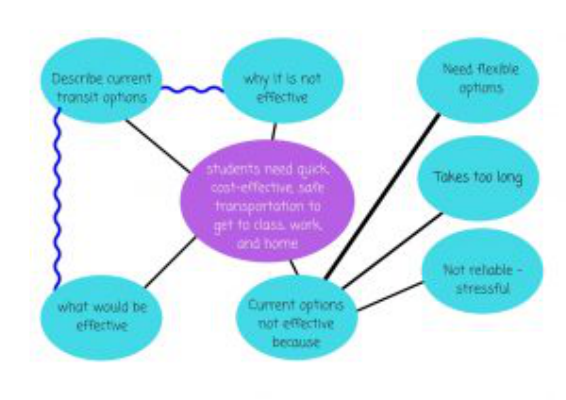
#;-71=-:
• Include details
This is where I can provide more information about each
point – below, I’ve taken one of the points and added to it:
Academic Writing Basics 41
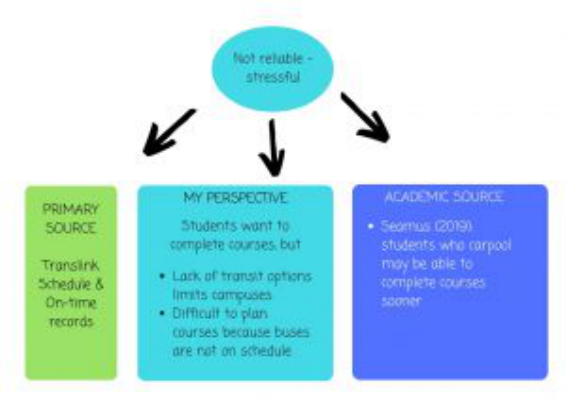
#;-7#1?:
• Analyze and improve map by asking questions
• How do ideas fit together?
• Have all necessary connections been made?
This is where I can step back and review my map and
keep the purpose of my assignment in mind. This is also
a good time to follow up on questions that I might have –
I can talk through my ideas with a classmate or visit my
instructor as I continue to develop and refine my ideas.
#;-7#-=-5:
• Update concept map as you learn more
• Ask key questions about connections between
42 Megan Robertson

ideas
I’ll keep my map with me as I meet with my instructor to
discuss my ideas and when I visit the library to locate any
academic resources that I might need; this way, I can keep
everything together.
1. “How to Create a Concept Map” by University
of Guelph Library CC BY-NC-SA 4.0↵
Academic Writing Basics 43

<;31515/
Once you have your concepts and know how you are going
to connect your concepts, you can start to shape your essay
by working on an outline. An outline can help structure
your writing – but it is flexible! Imagine that your outline is
your travel plan for what you want to do on your vacation
– you know which sights you want to see, which pictures
you want to take, and where you want to go. Once you
know this, you can then decide how you’re going to do
these things: what do you want to visit first? How will
you travel between destinations? How long will you stay in
each place?
45

“My work space” by oxana v on Unsplash
For your writing journey, an outline can help you answer
similar questions: which concept do you want to discuss
first? How will you travel between different concepts?
How much will you write about each concept?
Your outline helps you plan and structure what you want
to say and in what order you will say it. As your ideas
develop, you may adjust your outline so that it better fits
with the concepts you want to connect and the evidence
you will use to support your ideas.
You can follow this KPU learning aid to learn more
about structuring your outline.
46 Megan Robertson
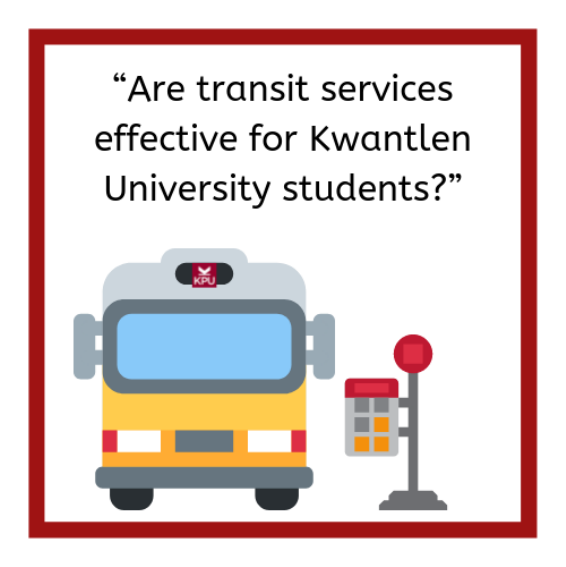
Using our example writing assignment, I can get started
on my outline.
I’ll group ideas and concepts into paragraphs:
Academic Writing Basics 47
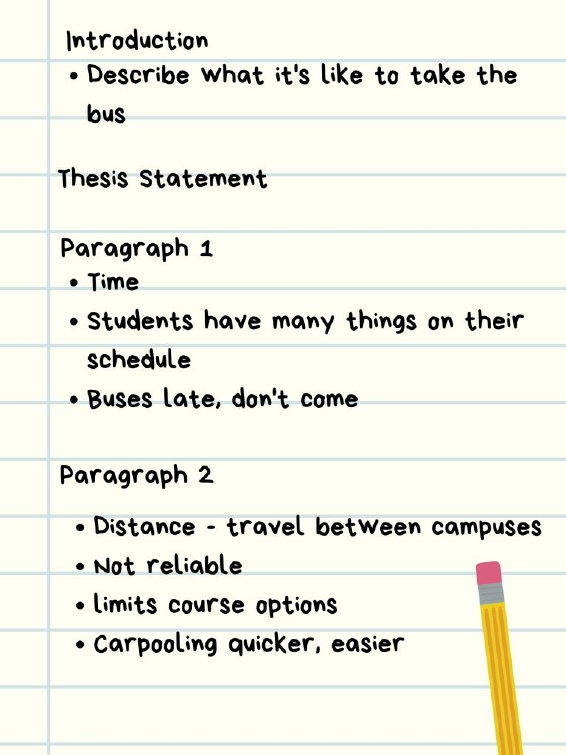
48 Megan Robertson
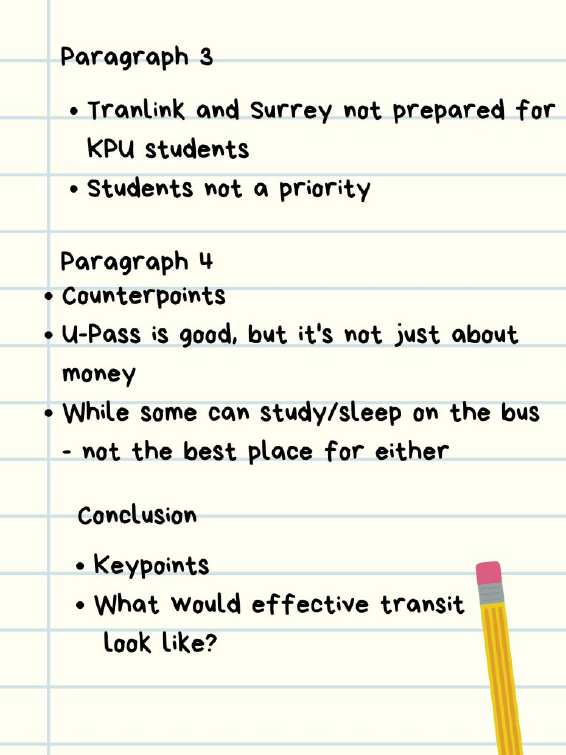
Right now, I haven’t written my thesis statement, but
that will be my next step.
If you are an intermediate or an experienced academic
writer, you might want to try creative graphic approaches
to outlining.
Academic Writing Basics 49
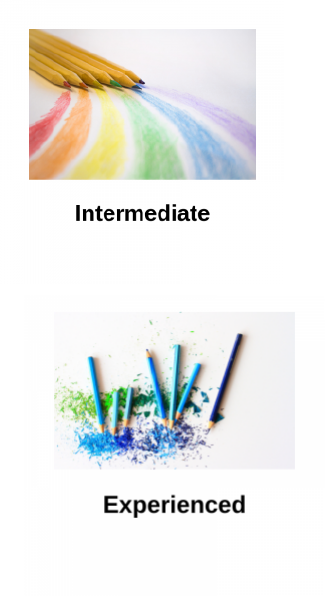
Below you can see an example of using text and drawing
to organize key ideas and assess options when putting
together a project.
50 Megan Robertson

-=-36715/(6<9$0-:1:#;);-4-5;
After you have started to develop your ideas and mapped
out the main concepts that you will cover in your
assignment, it can now be a good time to consider what will
be your thesis statement.
Remember that your thesis statement can change as you
continue to develop your ideas – using an outline can help
you keep checking on the connection between your body
paragraphs and your thesis statement.
Sometimes, thinking of a question can help you focus
your ideas and make connections.
In this video
1
, you can see how a question can be used
to structure and develop a thesis statement (Note, video
has no narration; a transcript of the text used on screen is
available below):
One or more interactive elements has been
excluded from this version of the text. You can
view them online here:
1. "How to Write a Thesis for Beginners" CC BY 4.0
53
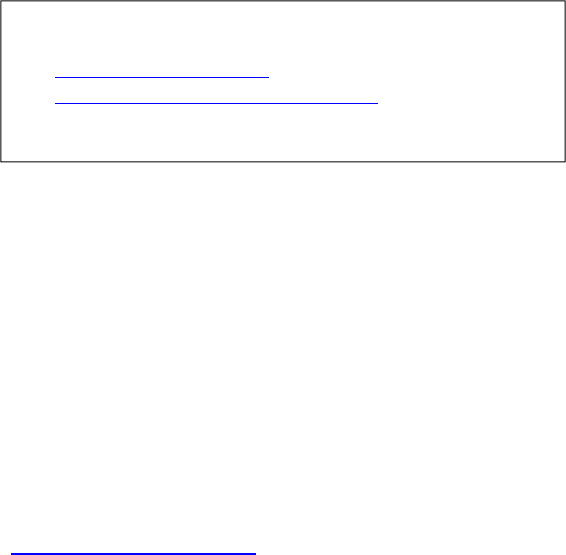
https://kpu.pressbooks.pub/
academicwritingbasics/?p=47#oembed-1
The three steps outlined in the video:
• Creating a question about your topic
• Finding reasons, and
• Putting it all together
are a good place to start if you are a beginner academic
writer.
Another strategy to developing a thesis statement is to
use the template suggested in this KPU Learning Aid on
“Thesis Statement Design:”
Using the KPU Learning Aid, we can return to our
example:
54 Megan Robertson
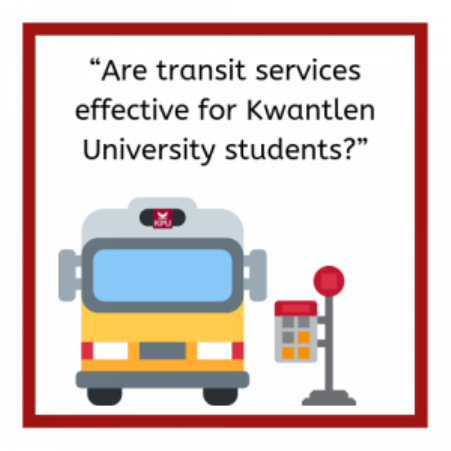
Here is the suggested template:
Academic Writing Basics 55
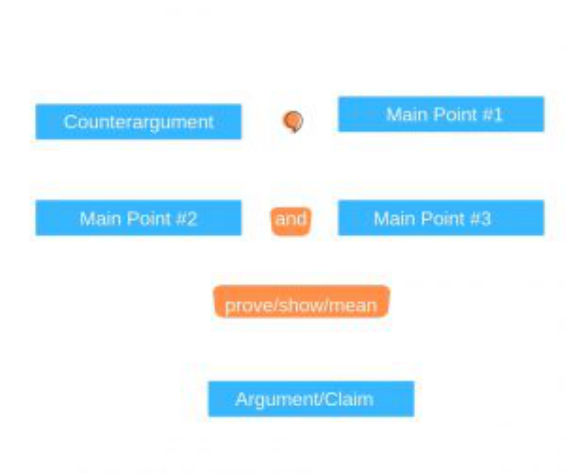
By beginning to to organize my ideas about effective
transit and KPU students, I can say:
56 Megan Robertson
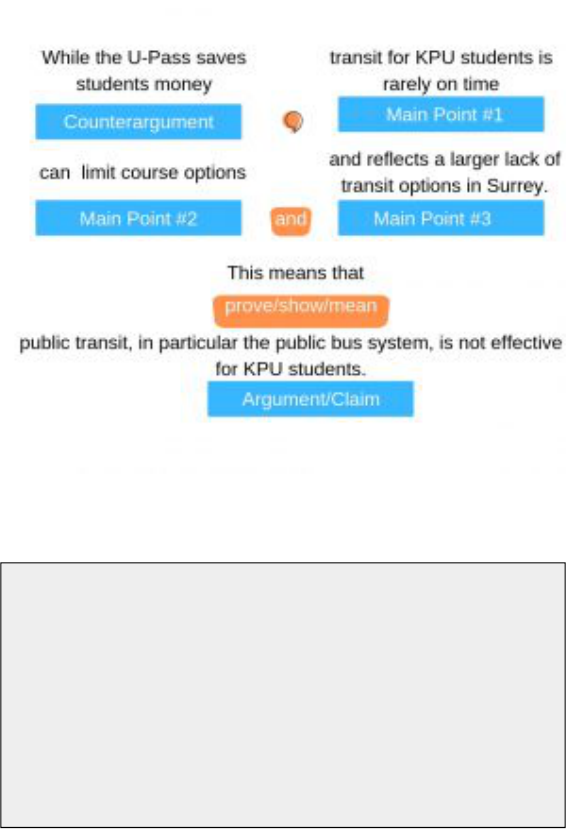
Right now, my thesis is two sentences:
While the U-Pass saves students money, transit
for KPU students is rarely on time, can limit course
options, and reflects a larger lack of transit options
in Surrey. This means that public transit, in
particular the public bus system, is not effective for
KPU students.
My thesis may change as I continue to write and revise
my essay. In the next chapter, we’ll look at more questions
Academic Writing Basics 57

suggestions you can use to further refine your thesis
statement.
Transcript for Text from “How to Write a Thesis for
Beginners”
Writing a Thesis Statement
Step 1 (creating a question about your topic)
What is your topic?
Superman
Form a question
Why is Superman so cool?
Step 2 (finding reasons)
What are some of the reasons that Superman is
cool?
(Try to think of at least 3 reasons)
Superman can fly!
He saves people from danger
Superman is really strong
That’s why he is Superman!
Step 3 (putting it all together)
We need to take the information from step 1 and
2 and combine it Make sure to answer your question
Why is Superman so cool?
Superman is so cool because
58 Megan Robertson

(part 1)
he is strong, helps people in danger, and he can
fly.
(part 2)
Remember your thesis is the road map for writing
your paper.
Make sure you write about what your thesis says.
Whether you are writing about Superman, China, or
Australia.
Academic Writing Basics 59

"-C515/(6<9$0-:1:#;);-4-5;
61

As you develop experience and confidence as a writer, you
can consider more steps to improve your thesis statement,
like those ones discussed in the University of Laurier
Library video
1
:
One or more interactive elements has been
excluded from this version of the text. You can
view them online here:
https://kpu.pressbooks.pub/
academicwritingbasics/?p=204#oembed-1
If you are able to:
• Make an argument
• Answer ‘so what?’
• Be specific
• Have only one idea
• Make it supportable
You can make improvements in your thesis statement.
See if you can identify strong thesis statements:
1. "Improving Your Thesis Statement" by Laurier Library CC BY 4.0
63
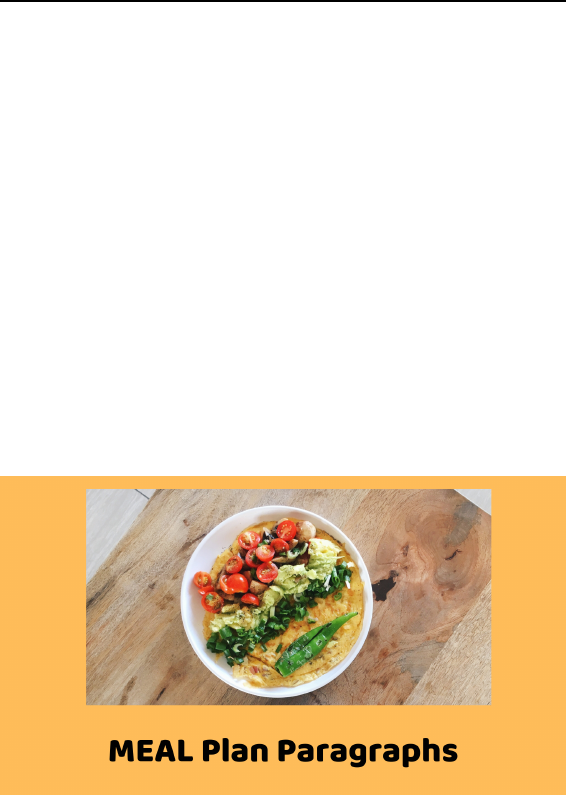
3)5515/(6<9'91;15/9).;15/
)9)/9)70:
Once you have an outline and a thesis statement, you can
work on the paragraphs in your assignment and start
writing your first draft.
Following the MEAL plan can help you structure your
paragraphs:
Click on the sections below to find out more about the
MEAL plan for paragraph drafting:
65
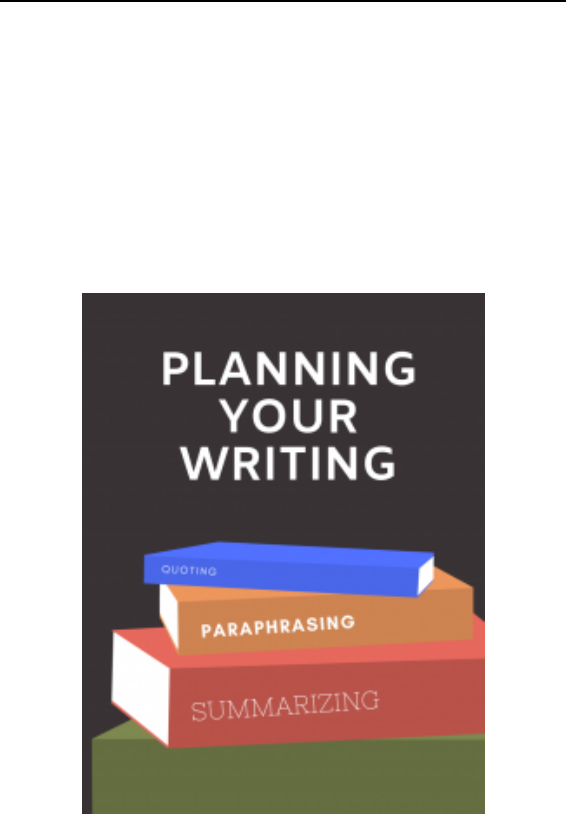
3)5515/(6<9'91;15/!<6;15/
)9)709):15/)5,#<44)91A15/
An important part academic writing is incorporating
evidence. To do this, you will need to know the basics of
quoting, paraphrasing, and summarizing.
Making sure that you are using evidence properly,
through quoting, paraphrasing, and summarizing, will
67
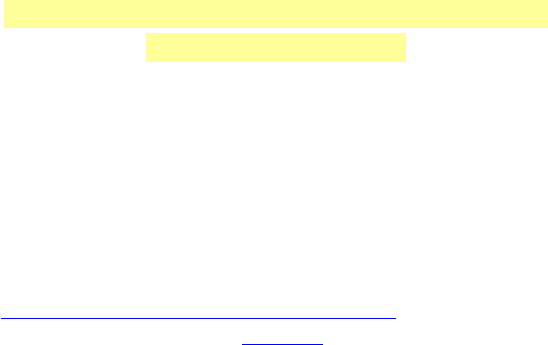
ensure that you are giving necessary credit for other
peoples’ words and ideas and will help you avoid
plagiarism.
The table
1
below describes three different ways of using
evidence:
Quoting
Using the author’s exact words. Always cite it
and use “quotation marks.”
Paraphrasing
Restating, in your own words, the author’s
words or ideas without altering the meaning
or providing interpretation. Paraphrases are
about the same length as the original. Always
cite it.
Summarizing
Condensing the author’s words or ideas
without altering the meaning or providing
interpretation—you use your own words for
this. Basically, presenting the original
information in a nutshell. Always cite it.
..-+;1=-3@8<6;15/7)9)709):15/)5,:<44)91A15/
)3>)@:15+3<,-:+1;);165
We’ll review some examples of how you can effectively
incorporate evidence to support your ideas in the next
section. Before we get there, make sure that you are
familiar with the citation style and reference style that you
1. "Quoting, Summarizing, and Paraphrasing in a Nutshell" by University of
California Los Angeles Library CC BY 4.0
68 Megan Robertson

are using for your assignment – these can be different for
different courses and assignments.
The KPU Library has guides to help you with make sure
that you are citing your work correctly, according to the
style that your instructor wants you to use. Visit their page
here.
If you have questions about how you should be citing
evidence, ask your instructor or check with one of the KPU
librarians.
Complete the KPU Plagiarism Awareness
Tutorial to learn more about academic integrity and
earn your Moodle badge.
967-93@#<44)91A15/)5, )9)709):15/
2
When you summarize, you should write in your own words
and the result should be substantially shorter than the
original text. In addition, the sentence structure should be
your original format. In other words, you should not
take a sentence and replace core words with synonyms
(different words with the same meaning).
You should also use your own words when you
paraphrase. Paraphrasing should also involve your own
sentence structure. However, paraphrasing might be as
long or even longer than the original text. When you
paraphrase, you should include, in your words, all the ideas
2. Material in this section is reproduced and adapted from "Making Ethical and
Effective Choices" by Saylor CC BY-NC-SA 3.0
Academic Writing Basics 69
from the original text in the same order as in the original
text. You should not insert any of your ideas.
Both summaries and paraphrases should maintain the
original author’s intent and perspective. Taking details out
of context to suit your purposes is not ethical since it does
not honor the original author’s ideas.
Review the examples in the table below to see the
difference between quoting, paraphrasing, summarizing,
and plagiarizing.
Here is a page from a book written by Maelle Jasper:
70 Megan Robertson
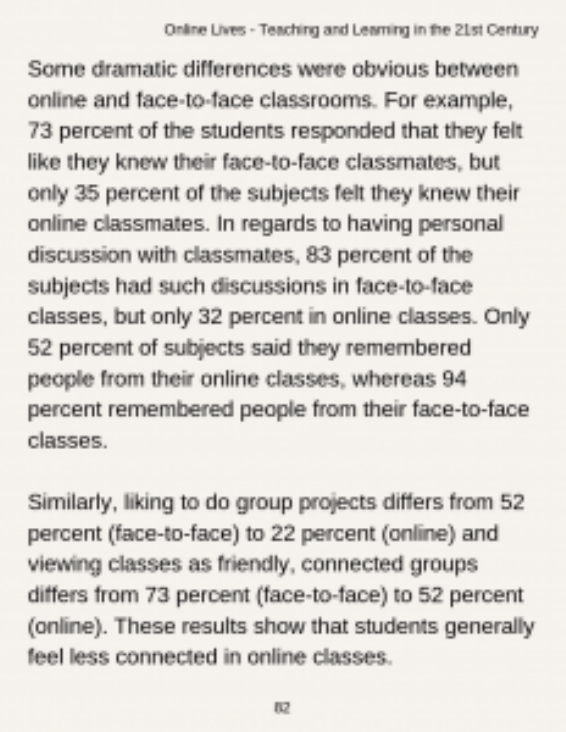
Academic Writing Basics 71
Quoted Text
The study showed that personal discussions
are much more likely to take place in
face-to-face classes than in online classes
since “83 percent of the subjects had such
discussions in face-to-face classes, but only 32
percent in online classes” (Jasper, 2016, p. 82).
Paraphrased
Text
Study results (Jasper, 2016, p. 82) show a clear
difference between online and face-to-face
classrooms. About twice as many students
indicated they knew their classmates in
face-to-face classes than in online classes.
Students in face-to-face classes were about
two-and-a-half times more likely to have
discussions with classmates than were students
in online classes. Students in face-to-face
classes were about twice as likely to remember
classmates as were students in online classes.
Students in face-to-face classes viewed group
projects as positive about two-and-a-half times
more often than did students in online classes.
Students in face-to-face classes saw class as a
friendly place 73 percent of the time compared
to 52 percent for online classes. Summing up
these results, it is clear that students feel more
connected in face-to-face classes than in
online classes.
Summarized
Text
Students report a more personal connection to
students in face-to-face classes than in online
classes (Jasper, 2016, p.82).
I
n
t
h
e
e
x
a
m
p
l
e
o
f
p
l
a
g
i
a
r
i
z
e
d
t
e
x
t
,
s
o
72 Megan Robertson

Plagiarized
Text
Some major differences were clear between
Internet and in-person classrooms. For
example, 73 percent of the study participants
felt they were acquainted with their in-person
classmates, but only 35 percent of the
participants indicated they knew their distance
classmates.
me of the words from the original text are replaced with
synonyms (different words with the same meaning).
Below you can see how the words that are underlined in
the original text have been replaced in the plagiarized text
with synonyms (highlighted in yellow).
Original
Text
Some dramatic differences were obvious
between online and face-to-face classrooms. For
example, 73 percent of students responded that
they felt like they knew their face-to-face
classmates, but only 35 percent of the subjects
said they remembered people from their online
classes.
Plagiarized
Text
Some major differences were clear between
Internet and in-person classrooms. For example,
73 percent of the study participants felt they
were acquainted with their in-person classmates,
but only 35 percent of the participants indicated
they knew their distance classmates.
The only noticeable difference between the original text
and the plagiarized text are the synonyms. This form of
plagiarism is also known as “patch writing.” The original
Academic Writing Basics 73

and the plagiarized text are identical, except for “patches”
where synonyms have been used.
Patch writing
3
You copy a short passage from an article you
found. You change a couple of words, so that it’s
different from the original. You carefully cite the
source. It is still PLAGIARISM because even
though you have acknowledged the source of the
ideas with a citation, your new passage is too close
to the original text. This form of plagiarism is called
patch writing. In patch writing, the writer may
delete a few words, change the order, substitute
synonyms and even change the grammatical
structure, but the reliance on the original text is still
visible when the two are compared.
3. "Quoting, Paraphrasing, Summarizing & Patchwriting Quotations" by College of
DuPage Library CC BY 4.0
74 Megan Robertson

3)5515/(6<9'91;15/5+69769);15/
=1,-5+-
In the previous section, we reviewed quoting,
paraphrasing, and summarizing. Academic writing uses
quoting, paraphrasing, and summarizing, together with
your own word and ideas to communicate your
perspectives.
One way to think about incorporating evidence is to
imagine that the person reading your writing visits a bakery
to pick up a pie. Your reader is expecting something like
this:
75

“Pie on wood slab” by Rebecca Matthews
on Unsplash
As a writer, your reader expects you to combine and
incorporate all of the ingredients in the proper order. If your
reader is expecting a well-made apple pie, but you don’t
combine the ingredients, like the picture below, the reader
might not be sure what to do with them.
76 Megan Robertson

“Baking a Pie” by Andy Chilton on Unsplash
Even if you have good ingredients, you need to blend
them together! When you are working on a writing
assignment, even if you identify good evidence to support
your thesis, you need to organize and incorporate that
evidence and supporting material with your own ideas and
your own writing.
So, how can evidence be incorporated with your own
ideas and your own writing?
There are three basic elements to keep in mind when
incorporating evidence:
1
Effectively using evidence is not just about properly
documenting your evidence, but also where and how you
1. From "Integrating Evidence into Your Writing" by University of Northern
British Columbia Academic Success Centre
Academic Writing Basics 77
incorporate evidence into your writing, and how you
explain its significance to your argument.
To effectively show the reader how evidence supports
your claims, use a well-organized
paragraph structure in combination with language signals.
Language signals such as “for example,” “therefore,” and
“in contrast,” for instance, help make connections and
transitions between ideas more clear to the reader.
Use this basic pattern as a guide to incorporate evidence
into your paragraph:
#;);-@6<9+3)14)5,,-C5-)5@;-94:;0);4)@
56;*-256>5;6@6<99-),-9
96=1,--=1,-5+-;0);:<7769;:@6<9+3)14
644-5;6506>;0--=1,-5+-:<7769;:@6<9
+3)14
The third element is where you clearly explain the
connection between your claim and the evidence to the
reader. Do not assume the reader automatically understands
the connections between your ideas—you must explain
them!
Using our example of a writing assignment that asks us
to discuss effective transit options for KPU students, we
can now do the following:
78 Megan Robertson
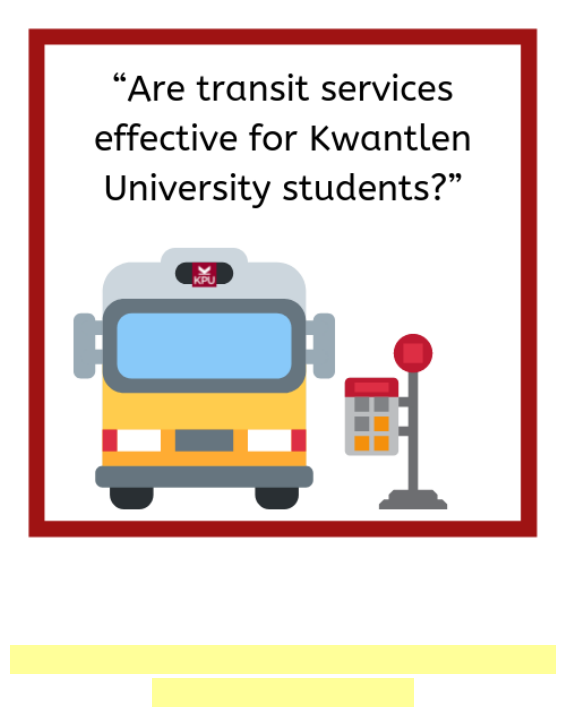
#;);-@6<9+3)14)5,,-C5-)5@;-94:;0);4)@56;
*-256>5;6@6<99-),-9
While Surrey has one of the largest populations in Metro
Vancouver, the “federation of 21 municipalities, one
Electoral Area and one Treaty First Nation” in southwest
British Columbia (Metro Vancouver, 2019, para. 1), it is
under served by public transit. Surrey’s current Skytrain
service, in particular, does not support the transportation
needs of Kwantlen students or the city’s residents.
• In the paragraph above we have:
Academic Writing Basics 79

◦ Defined a key term – “Metro
Vancouver”
◦ Incorporated a quotation from a
source into our sentences
96=1,--=1,-5+-;0);:<7769;:@6<9+3)14
Skytrain service extended to Surrey following Vancouver’s
hosting of Expo ’86 and by 1994, the ‘Expo Line’ included
20 stations stretching from Downtown Vancouver to
Surrey’s King George Station – one of fours Skytrain
stations in Surrey (Translink, n.d.). The City of Surrey
website notes that the city “has had an average annual
growth rate of 2% over the last 10 years” (City of Surrey,
n.d.). By 2021, an estimated 600,000 people will call
Surrey, but Skytrain service is not scheduled to expand.
• In the paragraph above, we have:
◦ Used specific evidence related to our
claim
◦ Incorporated evidence into our
sentences using quotation and
paraphrase
644-5;6506>;0--=1,-5+-:<7769;:@6<9+3)14
The lack of Skytrain stations in Surrey, and with no current
plans to build more, means that both Surrey residents and
80 Megan Robertson
Kwantlen students will struggle with reliable
transportation. Because of this growing population base,
more and more Surrey residents will make use of transit.
Regardless of where students attending Kwantlen’s Surrey
campus live, this growing population will create more
overcrowding on existing transit lines.
• In the paragraph above, we have:
◦ Explained why evidence matters – see
where we have used “means” and
“because”
Academic Writing Basics 81

3)5515/(6<9'91;15/=-9+6415/
*:;)+3-:
83

When you are trying to write your first draft, it can be
challenging to get started when facing a blank page!
“MacBook Pro near white open book” by Nick Morrison
on Unsplash
#6>0);+)5@6<,6
Just write. You already have at least one idea. Start there.
What do you want to say about it? What connections can
you make with it? If you have a working thesis, what points
might you make that support that thesis?
Review and update your outline. Write your topic or
thesis down and then jot down what points you might make
that will flesh out that topic or support that thesis. These
85

don’t have to be detailed. In fact, they don’t even have to
be complete sentences (yet)!
1
Create Smaller Tasks and Short-Term Goals. Your
assignment might seem too large, and maybe the due date
is weeks away. These factors can contribute to feelings of
being overwhelmed or with the tendency to procrastinate.
But the remedy is simple and will help you keep writing
something each week toward your deadline and toward the
finished product: divide larger writing tasks into smaller,
more manageable tasks and set intermediate deadlines.
Collaborate. Talk to your friends or family, or to a peer
tutor in The Learning Centre, about your ideas for your
essay. Sometimes talking about your ideas is the best way
to flesh them out and get your ideas flowing. Write down
notes during or just after your conversation. Classmates are
a great resource because they’re studying the same subjects
as you, and they’re working on the same assignments. Talk
to them often, and form study groups. Ask people to look
at your ideas or writing and to give you feedback. Set goals
and hold each other accountable for meeting deadlines (a
little friendly competition can be motivating!).
Talk to other potential readers. Ask them what they
would expect from this type of writing. Meet with a tutor in
The Learning Centre. Be sure to come to the appointment
prepared with a copy of the assignment and a clear idea of
what you want to work on.
2
Try to start writing well in advance of your deadline so
1. "Writing the First Draft" in The Word on College Reading and Writing by
Carol Burnell, Jaime Wood, Monique Babin, Susan Pesznecker, and Nicole
Rosevear CC BY-NC 4.0
2. Adapted from "Overcoming Writing Anxiety and Writer’s Block"in The Word
on College Reading and Writing by Carol Burnell, Jaime Wood, Monique
Babin, Susan Pesznecker, and Nicole Rosevear CC BY-NC 4.0
86 Megan Robertson

"-=1:15/(6<9'91;15/
Once you’ve worked on your draft, you need to revise and
edit your work. Revising will help you check if you’ve
responded to the assignment instructions and clearly
communicated your ideas. Revising will also help you will
help you correct grammatical, punctuation, and
presentation issues. When you are revising, try moving
through three different stages:
• Checking in on the Big Picture
• The Mid-view Review
• Editing Up Close
We’ll look first at Checking in on the Big Picture…
"-=1:15/#;)/-B0-+215/1565;0-1/ 1+;<9-
89

“Seeking Adventure” by Jasper van der Meij on Unsplash
When you first begin revising, you should focus on the
big picture. The following questions
1
can help guide you
with this:
• Do you have a clear thesis? Do you know what
idea or perspective you want your reader to
understand upon reading your essay?
• Is your essay well organized?
• Is each paragraph a building block in your
essay: does each explain or support your thesis?
• Does it need a different shape? Do parts need
to be moved?
• Do you fully explain and illustrate the main
ideas of your paper?
• Does your introduction grab the reader’s
1. Revising Stage 1 by Excelsior Online Writing Lab CC BY 4.0
90 Megan Robertson

interest?
• Does your conclusion leave the reader
understanding your point of view?
• Are you saying in your essay what you want to
say?
• What is the strength of your paper? What is
its weakness?
"-=1:15/#;)/-B$0-1,&1->"-=1->
“The south of Mexico” by Mitch Lensink on Unsplash
The second stage of revising requires that you look at
Academic Writing Basics 91

your content closely at the paragraph level. It’s now time
to examine each paragraph, on its own, to see where you
might need to revise. The following questions
2
will guide
you through the mid-view revision stage:
• Does each paragraph contain solid, specific
information, vivid description, or
examples that illustrate the point you are
making in the paragraph?
• Are there are other facts, quotations, examples,
or descriptions to add that can more clearly
illustrate or provide evidence for the points you
are making?
• Are there sentences, words, descriptions
or information that you can delete because
they don’t add to the points you are making or
may confuse the reader?
• Are the paragraphs in the right order?
• Are your paragraphs overly long? Does each
paragraph explore one main idea?
• Do you use clear transitions so the reader can
follow your thinking?
• Are any paragraphs or parts of
paragraphs repetitive and need to be deleted
Take a look at the paragraph
3
below and click the hot
spots to see suggestions for revision:
2. Revising Stage 2 by Excelsior Online Writing Lab CC-BY-4.0
3. "Revising Paragraphs" in Writing Skills Lab by Department of Writing and
Rhetoric at the University of Mississippi
92 Megan Robertson
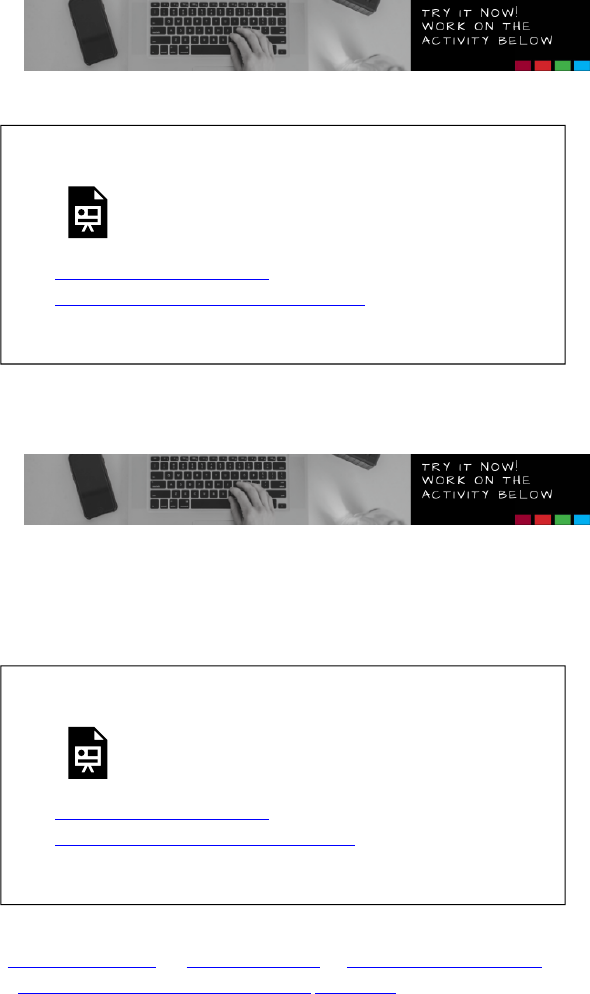
An interactive H5P element has been excluded
from this version of the text. You can view it
online here:
https://kpu.pressbooks.pub/
academicwritingbasics/?p=116#h5p-10
Practice: Revising Paragraphs
Review the paragraph
4
below and select the most
important revision that Sophie, the student writer, should
focus on in her revisions:
An interactive H5P element has been excluded
from this version of the text. You can view it
online here:
https://kpu.pressbooks.pub/
academicwritingbasics/?p=116#h5p-8
4. "Revising Paragraphs" in Writing Skills Lab by Department of Writing and
Rhetoric at the University of Mississippi CC BY 4.0
Academic Writing Basics 93

"-=1:15/#;)/-B,1;15/%736:-
Photo by Andrew Pons on Unsplash
Once you have completed your revision and feel
confident in your content, it’s time to begin the editing
stage of your revision and editing process. The following
questions
5
will guide you through your editing:
• Are there any grammar errors, i.e. have you
been consistent in your use of tense, do your
pronouns agree?
• Have you accurately and effectively
used punctuation?
5. Revising Stage 3 by Excelsior Online Writing Lab CC BY-4.0
94 Megan Robertson
• Do you rely on strong verbs and nouns and
maintain a good balance with adjectives and
adverbs, using them to enhance descriptions but
ensuring clear sentences?
• Are your words as accurate as possible?
• Do you define any technical or unusual
terms you use?
• Are there extra words or clichés in your
sentences that you can delete?
• Do you vary your sentence structure?
• Have you accurately presented facts; have you
copied quotations precisely?
• If you’re writing an academic essay, have you
tried to be objective in your evidence and tone?
• If writing a personal essay, is the narrative
voice lively and interesting?
• Have you spellchecked your paper?
• If you used sources, have you consistently
documented all of the sources’ ideas and
information using a standard documentation
style?
Academic Writing Basics 95

"-=1->)5,-?;#;-7:
5;01:9-:6<9+-@6<0)=-0),;0-67769;<51;@;6
• consider the process of academic writing;
• determine the type of academic writing you
might be asked to complete;
• review approaches to developing and structuring
ideas using concept mapping and outlining;
• work on how to develop a thesis statement or
controlling idea;
• consider strategies for planning your writing
assignment, including:
◦ drafting paragraphs
◦ quoting, paraphrasing, and
summarizing
◦ incorporating evidence, and
◦ overcoming obstacles;
• use key questions for revising and editing.
:@6<>69265@6<9>91;15/)::1/54-5;:;0- %
97





